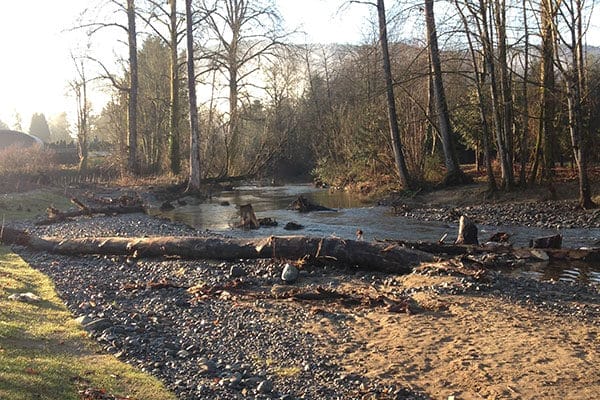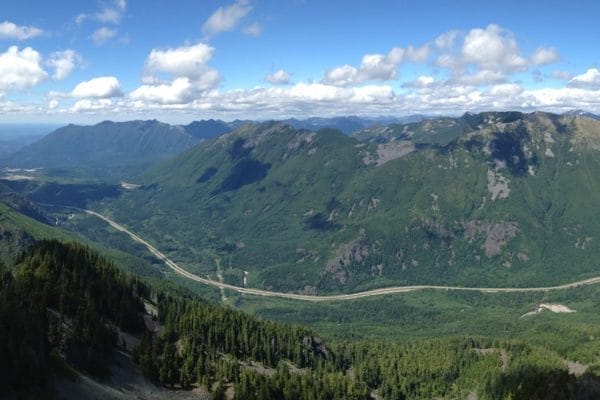Reflecting on the Last Ten Years in the Greenway
As we look toward 2020 and a new decade(!), we wanted to take a moment to reflect on the last ten years of Greenway work. From the building of Mailbox Peak to our designation as a National Heritage Area, and every big project in between, the last ten years have been busy with our partners and fellow collaborators. The following list barely touches the proverbial iceberg because we highlighted just some of the major milestones since 2010. Restoration and trail building crews, agency partners, volunteers, staffers, and donors have all made the Greenway what it is today, and we can’t wait to see what the next decade holds!
2010
- The Washington State Department of Transportation (WSDOT) constructed a regional trail connection from High Point to Preston, bridging a major gap in the regional trail system.
- The Bessemer Mountain Road Project removed 15 miles of roads on the west side of the Middle Fork Valley. As part of the effort, the US Forest Service (USFS) and Washington State Department of Natural Resources (WA-DNR) completed a road-to-trail conversion from the Mt. Si road into the Middle Fork.
- Lake Union Park opened. Made possible by the City of Seattle and the Seattle Parks Foundation, this 12-acre Seattle park includes walking paths, lake shore access, maritime history, and a model boat pond.

Lake Union Park. Photo: SPF Staff
2011
- The City of Issaquah acquired 140 acres on the forested west flank of Tiger Mountain to preserve highly visible forest land from planned development.
- The Snoqualmie Tribe undertook a major ecological restoration project along the Snoqualmie River in Fall City to improve salmon and wildlife habitat.
- The 20th Anniversary Trek from Ellensburg to Seattle commemorated the 1990 March event that inspired the original idea for the Mountains to Sound Greenway.

2012
- The City of Seattle and the WA-DNR conserved 150 acres added to the Raging River State Forest between Tiger Mountain and the Cedar River Watershed.
- The Yakama Nation reintroduced sockeye salmon into Lake Cle Elum and celebrated the 16th anniversary of its salmon recovery facilities in the Upper Yakima Basin at the annual Salmon Feed attended by over 500 people.
- Kirkland purchased a 5.75-mile segment of the Eastside Rail Corridor that runs from the southern edge of the city to Totem Lake for a multi-modal trail.
- WA-DNR opened the new 1.4-mile East Tiger Summit Mountain Bike Trail in Tiger Mountain State Forest, the first new mountain bike trail built on Tiger Mountain in 20 years.
- King County acquired 22 acres in the Three Forks Natural Area, creating a key link in the Snoqualmie River wildlife and recreation corridor.

2013
- The City of Issaquah created Confluence Park, where the three forks of Issaquah Creek meet, following years of conservation and restoration efforts to restore the stream’s natural meander and improve salmon habitat.
- The Greenway, WA-DNR, and USFS continued efforts to permit and design new trails, trailheads, river access points, and picnic areas to accommodate increased public use in the Middle Fork, including a new Dingford Creek Trailhead that was completed with new parking spaces, trail signs, and picnic tables.
- WSDOT opened three newly reconstructed miles of I-90 just east of Snoqualmie Pass that includes wildlife crossings.
- Washington State Parks repaired and reopened two historic tunnels in Iron Horse State Park (now called the Palouse to Cascades State Park Trail) near Easton, allowing recreationists to travel the Trail east of Snoqualmie Pass.
- During the first on-the-ground product of the Yakima Basin Integrated Plan, the Manastash Creek Project opened 25 miles of critical habitat to migrating salmon through the creation of a new irrigation pipeline and removal of a water diversion system that dried up part of the creek every year.
- In culmination of the hard work of numerous non-profit organizations and government agencies, Washington State purchased over 50,000 acres – roughly 80 square miles – to create and conserve the Teanaway Community Forest near Cle Elum.

2014
- The new Mailbox Peak trail opened. Built by WA-DNR in partnership with the Greenway Trust, Washington Trails Association (WTA), and EarthCorps, it replaced the old trail – a daunting ridge route frequently requiring search and rescue personnel to help lost or injured hikers.
- Kittitas Conservation Trust improved two miles of connections between the lower Cle Elum River and side channel habitat – critical for salmon spawning – by adding woody material to the river and reconstructing segments of the channel to reconnect the floodplain.
- The Nature Conservancy finalized an agreement to purchase 41,500 acres of Plum Creek Timber land including key lands such as Cle Elum Ridge, adjacent to the new Teanaway Community Forest, and the majority of the infamous “checkerboard” lands that have posed a host of challenges to Washington land managers for a century.

2015
- King County conserved six Snoqualmie Valley farms through its agreement with the city of Seattle that enables farmers to sell development rights, moving them from agricultural areas to urban areas.
- King County and the Snoqualmie Watershed Forum – a partnership including the Snoqualmie Tribe and the cities of Duvall, Carnation, North Bend, and Snoqualmie – completed a Snoqualmie River restoration project reconnecting 50 acres of floodplain habit to the river to benefit threatened chinook and steelhead salmon.
- As part of its “Every Trail Connects” campaign, REI members voted for worthy trail projects and cast more than 12,000 votes for the Middle Fork Trail. As a result, REI donated $70,000 to rebuild an impassible section of the Trail.
- 25th Anniversary from Ellensburg to Seattle commemorated the 1990 March event that inspired the original idea for the Mountains to Sound Greenway.
2016
- The Greenway launched Savor Snoqualmie Valley a new initiative to mobilize the Snoqualmie River Valley community, bringing together over a hundred community, government, and business leaders to build a more united Valley.
- Washington State Parks relined a crumbling tunnel on the John Wayne Pioneer Trail (now called the Palouse to Cascades State Park Trail) near Thorp, improving public safety and access to the Yakima Canyon.
- Seattle City Light acquired 154 acres of private land along Stossel Creek in the Tolt River watershed, allowing restoration of wetlands and important coho and steelhead salmon habitat, and enabling future access points to adjacent trails.
- Community volunteers contributed over 1,000 hours to restoring Issaquah Creek, planting native trees, and building a new playground at Lake Sammamish State Park.

2017
- After two decades of work by many partners including the Federal Highway Administration, the reconstructed Middle Fork Road opened.
- The new 520 bridge opened across Lake Washington providing new amenities for pedestrians and cyclists and connections to regional trails.
- The Yakama Nation obtained funds to expand treatment and monitoring of eight additional miles of streams in the Teanaway Basin – a continuation of tireless efforts to improve habitat for coho, cutthroat, and steelhead salmon.
- The Federal Highway Administration, the USFS, WA-DNR, and the Greenway Trust collaborated to complete a new bridge to Pratt Bar providing safe, family-friendly access to a sunny gravel beach on the Middle Fork river and a spectacular water-play area with soaring views of surrounding mountains.
- King County Metro and King County parks launched Trailhead Direct as a pilot program to provide public transportation access from the Issaquah Transit Center to several popular Cougar and Tiger Mountain trailheads.

- King County and the Greenway teamed up to offer the Clean Water Ambassador Internship, an intensive hands-on program for local high school students to build the next generation of environmental leaders.
2018
- Through unprecedented philanthropic investment by both private citizens and corporate partners like The Boeing Company and REI Co-op, the Middle Fork campaign raised more than $6 million towards its $20 million goal in just two years.
- The Snoqualmie Tribe completed a major ecological restoration of critically important salmon habitat along the Tolt River incorporating hundreds of volunteers, a Tolt Middle School field study, the King County Clean Water Ambassadors, and the Greenway Education program.
- WSDOT completed a new 150-foot wide wildlife overpass – part of the I-90 Snoqualmie Pass East project – a game-changer for large-scale wildlife habitat connectivity and larger efforts to live in sustainable harmony with the lands and creatures of the Greenway.
- The Kittitas County Parks and Recreation District, working with the community and non-profits, completed a Towns to Teanaway Master Plan for a trail system linking the towns of Cle Elum, Ronald, and Roslyn to the Teanaway Community Forest. It also partnered with REI’s annual Leadership Conference to put 325 store managers and executives from around the country to work constructing the first trail connection to Cle Elum Ridge.
2019
- The Mountains to Sound Greenway became a National Heritage Area. This designation provides new opportunities to more effectively conserve natural resources, protect cultural heritage, and contribute to the economic vitality of the region.

- Major projects in the Middle Fork Valley, including two new trails — Garfield Ledges and Oxbow Loop Trail were completed. With funding raised by the Backcountry Horsemen of Washington and lumber donated by TRA Mill at cost, volunteers replaced the aging deck of the Gateway Bridge in the Middle Fork Valley.
- WA-DNR, WTA, Washington Climbers Coalition, Washington Conservation Corps, the Access Fund, and the Greenway Trust combined forces to build a 4-mile round trip trail to Dirty Harry’s Balcony.
- The City of Bellevue broke ground in the Factoria area on the first phase of a 3.6-mile segment of the Mountains to Sound Greenway Trail for both bicyclists and pedestrians.
- Carter Subaru’s On the Road to Carbon Neutral campaign reached the milestone of 200,000 trees planted in the Greenway, contributing to King County’s goal to plant one million shade trees near creeks to improve salmon habitat and increase climate resistance.
- The City of Issaquah, King County, and TPL came together to protect the 45-acre Bergsma property, a forested, highly visible property on the flank of Cougar Mountain originally proposed for residential development. The property’s proximity to the Issaquah Transit Center provides new and more equitable access to trails by public transportation.






